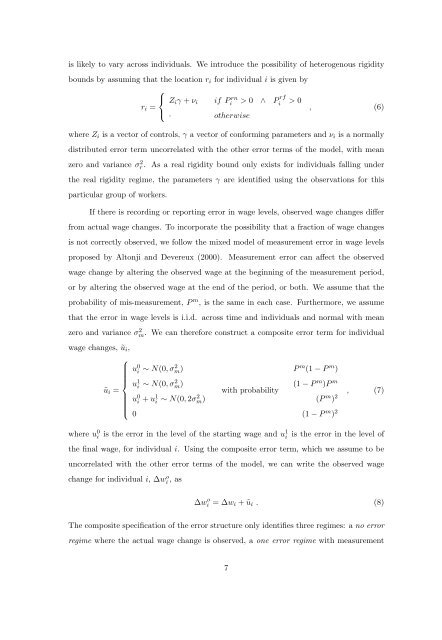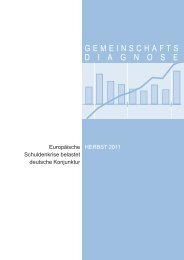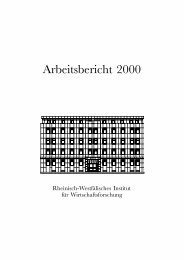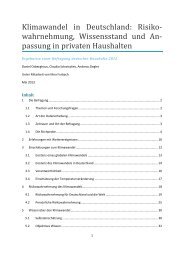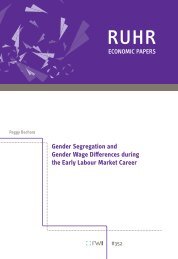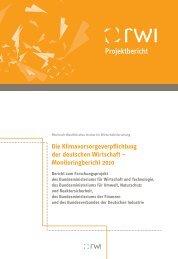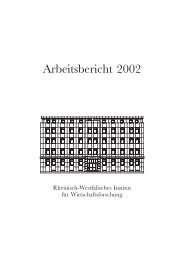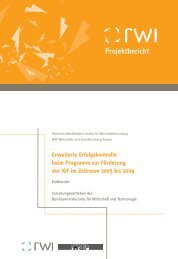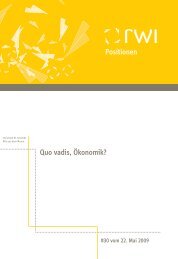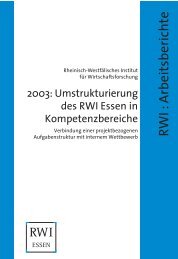RW I:Discussion Papers - Rheinisch-Westfälisches Institut für ...
RW I:Discussion Papers - Rheinisch-Westfälisches Institut für ...
RW I:Discussion Papers - Rheinisch-Westfälisches Institut für ...
You also want an ePaper? Increase the reach of your titles
YUMPU automatically turns print PDFs into web optimized ePapers that Google loves.
is likely to vary across individuals. We introduce the possibility of heterogenous rigidity<br />
bounds by assuming that the location r i for individual i is given by<br />
⎧<br />
⎨ Z i γ + ν i if Pi rn > 0 ∧ P rf<br />
i<br />
> 0<br />
r i =<br />
, (6)<br />
⎩<br />
· otherwise<br />
where Z i is a vector of controls, γ a vector of conforming parameters and ν i is a normally<br />
distributed error term uncorrelated with the other error terms of the model, with mean<br />
zero and variance σr. 2 As a real rigidity bound only exists for individuals falling under<br />
the real rigidity regime, the parameters γ are identified using the observations for this<br />
particular group of workers.<br />
If there is recording or reporting error in wage levels, observed wage changes differ<br />
from actual wage changes. To incorporate the possibility that a fraction of wage changes<br />
is not correctly observed, we follow the mixed model of measurement error in wage levels<br />
proposed by Altonji and Devereux (2000). Measurement error can affect the observed<br />
wage change by altering the observed wage at the beginning of the measurement period,<br />
or by altering the observed wage at the end of the period, or both. We assume that the<br />
probability of mis-measurement, P m , is the same in each case. Furthermore, we assume<br />
that the error in wage levels is i.i.d. across time and individuals and normal with mean<br />
zero and variance σm. 2 We can therefore construct a composite error term for individual<br />
wage changes, ũ i ,<br />
⎧<br />
u 0 i ∼ N(0,σ2 m)<br />
P m (1 − P m )<br />
⎪⎨ u 1 i<br />
ũ i =<br />
∼ N(0,σ2 m)<br />
(1 − P m )P m<br />
with probability<br />
, (7)<br />
u 0 i + u1 i ∼ N(0, 2σ2 m)<br />
(P m ) 2<br />
⎪⎩<br />
0<br />
(1 − P m ) 2<br />
where u 0 i is the error in the level of the starting wage and u 1 i is the error in the level of<br />
the final wage, for individual i. Using the composite error term, which we assume to be<br />
uncorrelated with the other error terms of the model, we can write the observed wage<br />
change for individual i, ∆w o i ,as ∆w o i =∆w i +ũ i . (8)<br />
The composite specification of the error structure only identifies three regimes: a no error<br />
regime where the actual wage change is observed, a one error regime with measurement<br />
7


